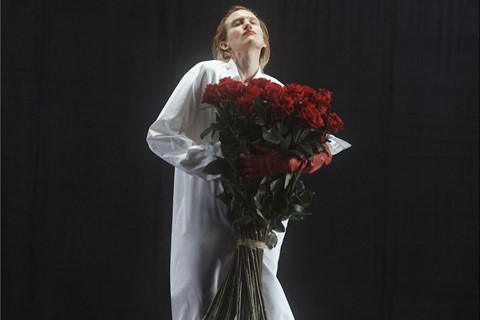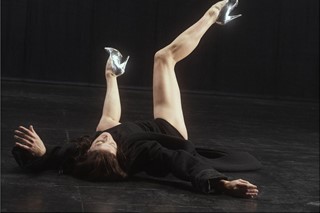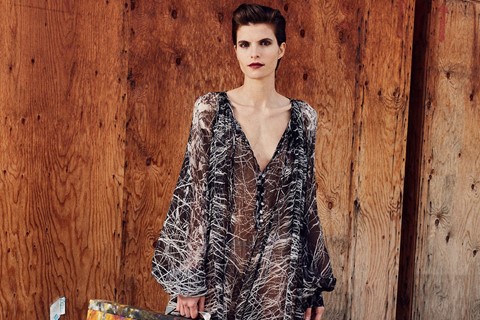This article is taken from the Spring/Summer 2021 issue of AnOther Magazine. To celebrate our 20th anniversary, we are making the issue free and available digitally for a limited time only to all our readers wherever you are in the world. Sign up here.
A radical classicist meets a classic radical: the fashion designer Dries Van Noten and Sterling Ruby, the artist who launched his own clothing line, S.R. STUDIO. LA. CA., in 2019, first physically met on a railway platform in Antwerp that year. Each already knew of the other, of course, having not only a deep respect and admiration for each other’s work, but a certain innate kinship. They are connected through craft, colour and a love of the transformative power of dress. Even though, on the surface, they are from two very different worlds.
Dries Van Noten, who comes from a family of tailors, has been a fashion stalwart since the 1980s. He designed his first menswear collection in 1986. That same year he opened his first boutique in Antwerp, where he was born and raised, where he studied (at the esteemed Royal Academy) and still lives and works. He has shown his womenswear in Paris since 1993, acclaimed consistently for his painterly mixes of pattern and hue. Van Noten’s references to art are frequent but never slavish: one collection drew its distinct, intensely unusual palette – of purple bruise, ochre and a pink that Suzy Menkes described as “rotting shrimp” – from the work of Francis Bacon. Once you knew, you wondered why you hadn’t figured it out earlier. Van Noten’s fine art interests and inspirations were laid bare in his 2014 retrospective exhibition at the Musée des Arts Décoratifs in Paris, where his pieces were placed alongside works by Yves Klein and van Dyck, Boldini, Bronzino and Richter. But Van Noten doesn’t believe in a hierarchy or snobbism: his clothes were not just laid next to artworks but cleverly juxtaposed with archive haute couture – works by Gabrielle Chanel, Cristóbal Balenciaga, Yves Saint Laurent – as well as pictures of flowers and a still from a Pedro Almodóvar film. The entire expansive exhibition was like a giant moodboard – or maybe a febrile, multifaceted mind, generously unspooled for us to better understand the creative collage behind Van Noten’s clothes.
Collage is the term Sterling Ruby uses most frequently to describe his artwork – combining disparate disciplines and approaches in single exhibitions, or even single bodies of work. Textiles, however, have always been central: his mother gave him a battered Singer sewing machine when he was 13, and he began customising his clothes. Born in Bitburg, Germany, to a military father and a Dutch mother, Ruby was raised in America, first in Baltimore and then a rural community in Pennsylvania. Craft was part of life – he has cited his mother’s West German pottery and dishware collection, Amish quilts and the carpentry skills of the Pennsylvania community as influences. Traces of all can be seen in his art. His interest in not only textiles generally but fashion specifically was reflected first in 2014 in a highly successful collaboration with Raf Simons, then five years later with the launch of S.R. STUDIO. LA. CA. That was founded despite initial kickback from art dealers and even collectors – now, unique pieces from the brand have been acquired by both art and fashion institutions.
This January, Ruby showed his latest collection as part of the Paris haute couture season – although it was actually a film recorded in the small industrial city of Vernon, California, where his studio is based. After that presentation – and in the midst of preparations for Van Noten’s Autumn/Winter 2021 collection – the two creative minds came together to bridge not only some 5,400 geographic miles, but the possibly even greater divide that remains between art and fashion.

Dries Van Noten: I knew, of course, your work in galleries in Brussels, Sterling. They show your work often. And I knew the collaboration that you did with Raf, and then you did that amazing show at Pitti Uomo. One week after that show, I saw you sitting, waiting to take the train to London, I think, at the train station in Antwerp. And I said to myself, “I think that’s Sterling.” I simply went up to you to have a chat and to congratulate you, because I really loved the work. I was really amazed by it. That’s how we met.
Sterling Ruby: I think maybe we were both going to Paris, but I was sitting there at the train station with my family. We had been in Italy and I have family in the Netherlands. We’d been in Eindhoven for a little bit, and then I got a tap on my back and I turned around and it was Dries Van Noten. I don’t know, Dries, maybe that happens all the time at the Antwerp train station. You see everybody?
DVN: Antwerp is a village. Of course, it’s also quite strange that now you won’t be able to tap on somebody’s shoulder. You have to keep one metre apart.
SR: I know. But it was a very, very natural, completely unorganised way of meeting one another.
DVN: Which is the best, I think.
SR: I think so, too. I know Belgium very well because of my family’s proximity to the border – even as a kid I would go with my mother. We lived in the States, but we would go every year to visit family in the Netherlands – we would always take day trips to either Antwerp or Brussels. I was very accustomed to the city and then, of course, as I started to make friends in the fashion world, it was kind of amazing that 90 per cent of them were living in Antwerp. Whether it was Pieter Mulier or Matthieu [Blazy]. Whenever we go to Europe, we spend most of our time in Belgium.
“The most influential creatives I’ve admired – a writer, a film director, a designer or an artist – have always responded to their time in history” – Sterling Ruby
DVN: I’m glad I got to meet you, because I love your art and fashion. I think, for a lot of people, art and fashion is a love-hate relationship. Especially from the art side, you have a lot of people who look down on fashion, because fashion as a field is commercial, whereas for me ... I don’t want to say that fashion is art, but I think fashion is an act of creativity, and I think art is also an act of creativity. That doesn’t mean that fashion is art for me, because in fashion you always have that commercial backdrop. But you have that whole grey zone in between, which I think is super-interesting.
I think that’s also what was visible in the exhibition we did in Paris [in 2014], where you have all sorts of examples of that relationship between fashion and art, which is sometimes so incestuous.
SR: I agree, 100 per cent. I think it’s different for everyone. Thinking about what I get excited about, I try to understand the aspects of both fields, how they feel the same for me. Whether it’s trying to create something new that I don’t know how to make yet, or seeing something that gets developed in a medium such as ceramics, which then moves into the textile studio.
I also like to try to find whatever comes across in either field that strikes a chord, something that blurs those boundaries, that doesn’t necessarily allow itself to be categorised. But I also hear what you are saying, about the art world looking down on fashion as if it’s this commercial enterprise, which, sure, it is, but so is a lot of art as well.
I was watching Pretend It’s a City, the Fran Lebowitz documentary, and she and Scorsese are talking about the fine arts. It’s this discussion about the way that most people – particularly the press – look at fine art now through the lens of monetary value. I have to keep reminding myself that there’s some real hypocrisy in seeing one as less than the other, art and fashion, fashion and art.
DVN: They’re united by craft. Craft to me is very important. Craft, you can also consider as the savoir-faire, the know-how to make something – which, of course, I’m very, very nervous about losing. You see now with the whole evolution – especially after the Covid-19 crisis – I’m very worried about how many of those small suppliers, who have so much knowledge, can survive.
We estimate how much what’s happening now is changing our view of everything – the things we knew before. I think we’re going to live in such a different world after this. I definitely hope so. I’m scared like hell that, at the end, we will go back to the old system and the ‘good old days’. I think we have to move on. You learn. We have to learn now from everything that is happening and blur the lines between what we are doing. Not everything has to be pigeonholed. What is fashion, what is art?
And craft is going to be so important, because the touch of humans is ... Maybe we also lost that a little bit.
SR: There’s been a shift in acceptance of the handmade in a younger generation. Yet within art, and within fashion, sometimes you see these pieces and they are essentially made by the highest of highest production facilities. And they feel like nobody has touched them, that they came to fruition with no real heart.
I come from a deep community of craft, where craft was very divided in the way you are talking about it. It was a discipline – you knew how to make something from wood, or metal, or textile – but also a kind of emblem. The idea that an object was made to be given out of love, that it was worth more because of that. I do believe that the handmade is becoming a little bit more of a symbol of our times, strangely enough. And maybe that’s just because, particularly right now, we don’t have touch.
I’m sure, Dries, for you, too. It’s hard when you make something and you’ve put it online or you do a lookbook with it, but really what you want is for somebody to touch it.
DVN: It’s both. I fully embrace the contemporary, the future, the whole evolution we’re going through, but I always say that I have a lot of respect for the past and a lot of “expectation” of the knowledge, of the savoir-faire. And I think that’s something you can’t forget. The world would be very poor and cold without it. The future is great but the past is also not so bad. We have to find a balance.
“Colour is really something. It’s fantastic to play with – it’s a lexicon of emotions for me” – Dries Van Noten
SR: Absolutely.
DVN: Now in fashion, quite often, we are spoiled brats. We can do whatever we want. We have the money to pay for the most amazing fashion shows. If we want to make it rain on a fashion show, we can make it rain. If we want fake sunshine, we can have fake sunshine. Now, poof! You can’t have contact any more. Now we have to bring emotion by Zoom, by video, by photographs.
How can you do that? You can’t see clients any more so you have to reinvent, but with a lot of limitations. And in fact, it’s quite stimulating because you start to see some of the things we’ve lost.
SR: I think the biggest thing is to reflect on this past year and know that, despite everything, space has been cleared for some very internal moments. I haven’t travelled at all, really since February of last year. No socialising unless it’s Zoom. And it’s true, the first couple of months, I was kicking back on it. I have a small studio, which I’m sitting in now at my house, and I did everything from here. I had to teach myself all of these digital things that I wasn’t at ease with before. I like to take notes, to have paper around me. I tend to make drawings and put dimensions on things, just notes. Not necessarily drawing as art, but I gravitate towards working that way, and that was something that I had to cut myself off from.
DVN: Freeing is not really the word that I want to use for that, but it pushed you. It pushed you forward and it forced you. It forced you to rethink what is really necessary.
So we are forced to make decisions. We are forced to change. I think it’s healthy. It’s like we are forced to eat a little bit less and now to see what we can do with the energy that is left. We are on a diet, let’s say.
SR: The most influential creatives I’ve admired – a writer, a film director, a designer or an artist – have always responded to their time in history. I find it to be a nice marker for where I am, and again I try not to make my art so didactic that it is specifically reflexive enough to say, “He’s taken this position.”
I’m trying to make these nuanced, almost abstract, nods to living through reality. I think my art has always been political, in one way or another. So it’s hard for me to consider that, even in the lead-up to the current situation, the work I was making didn’t engage with what was going on in the world – either in a global sense, or more regionally in America.
Dries, I’ve read before that you made a statement – it’s definitely not verbatim, sorry – that you make work that looks towards the future. That even though history interests you, you don’t want to make work about the past, that you want to make work that is predominantly looking forward.
DVN: In the end, fashion has to reflect what’s happening in the world and moderate it. Fashion has to be, to use a very fashionable word, relevant, because otherwise it’s an anachronism.
But I have to admit that in the last years, with Boris Johnson, Brexit, Trump, everything that was happening, I started to think more of fashion as a kind of escape. My collaboration with Christian Lacroix was about that – it was really going back to the late 1980s, that haute couture atmosphere when Christian started. And the moment the collection was delivered, all the stores were closed.
The collections I make now – it’s not that I want to make grim collections. I still want to look to the future. When we did the collaboration with [the foundation of the late New Zealand artist] Len Lye and the Viviane Sassen shoot, it was about finding emotion in a different way. It was not tactile, it was purely theoretical. I wanted to bombard people with colours.
SR: Colour for me is such a simple thing to gravitate towards or use, but it also winds up expressing this extremely complex range of emotions. I like to think of colour as psychological, both theoretically and instinctively. When I look at layers and prints and this kind of gradation of both colour and design, I like to think of it as collage – I also kind of feel that way about your work as well.
I like putting colours side by side – groupings – different nods to different moods. It almost feels like a psychological map, but it is also simple. I love that you can get away from all of the theory, all of the kind of constructs of heavy, laden discourse and really narrow it down to something that’s red and bright, or yellow and cheery, or burgundy and dark. When you can level all aspects of understanding, people just gravitating towards it by emotion.
DVN: Sterling, you said everything. You said it all. Colour is really something. It’s fantastic to play with – it’s a lexicon of emotions for me.
But quite often I want to use them by coincidence – I think the best colour combinations for me happen when I have a bunch of fabrics on the table and my eye falls on them. Something my mind would never put together because there are always the limitations where in your mind you could say, “This is possible, this is not possible.” But you have to break the rules.
This article originally featured in the Spring/Summer 2021 issue of AnOther Magazine which will be on sale from 8 April, 2021. Pre-order a copy here and sign up for free access to the issue here.












